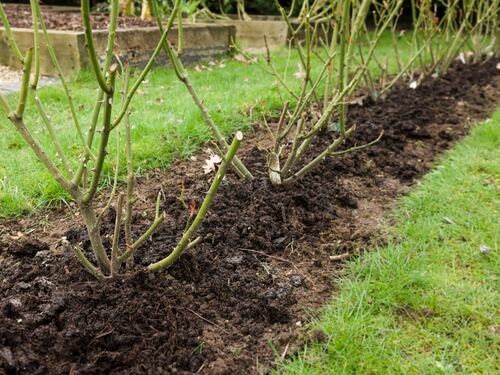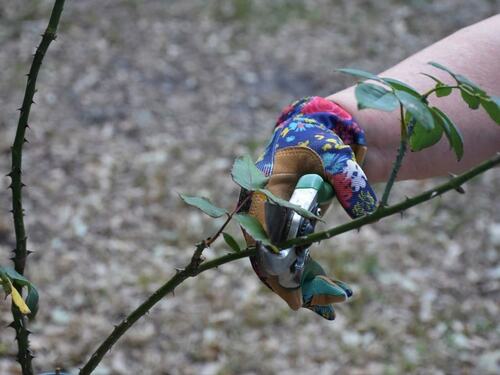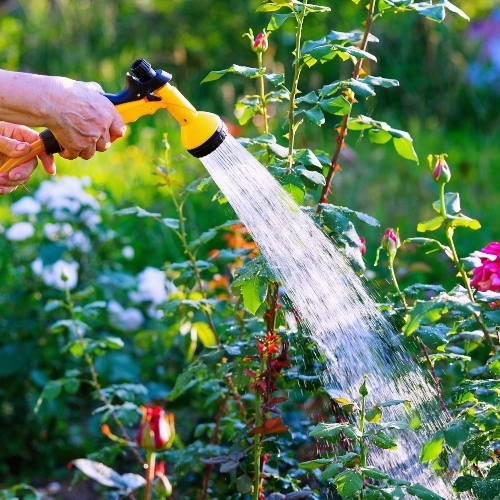Pruning Roses in Late Winter: A Comprehensive Guide
Introduction
Late winter, when plants are dormant , is an ideal time for many pruning tasks. Among these, pruning roses stands out as a crucial activity to ensure healthy growth and abundant blooms in the coming season. Whether you’re a seasoned gardener or a novice, understanding the proper techniques for pruning roses can make a significant difference in your garden’s beauty and vitality.
Why Prune Roses in Late Winter?

A Row of Winter-Pruned Rose Bushes
Late winter is the optimal time to prune most roses because the plants are still dormant, which reduces stress on the bushes. Pruning at this time helps to remove dead or damaged stems, shape the plant, and promote better air circulation, which is essential for disease prevention.
Timing Your Pruning Based on Hardiness Zone
Typically, January or February are safe for pruning roses. However, the exact timing depends on your rose type and your hardiness zone. In milder climates, you might prune earlier, while colder regions may require you to wait until the danger of frost has passed. If you’re unsure, observe your plants over a season to determine the best time to prune in your area.
Essential Tools for Pruning Roses

A Gardener Safely Prunes a Rose Bush – Image by Ray Shrewsberry from Pixabay
Before you begin pruning, gather the necessary tools to ensure a clean, efficient job.
1. Protective Gear
Heavy-duty gardening gloves with extra-long arm shields are essential to protect your hands and arms from the sharp thorns.
2. Pruning Tools
- Bypass Hand Pruners: Ideal for small branches up to two inches in diameter
- Loppers (Long-Handled Pruners): Useful for thicker canes and hard-to-reach areas
Cleaning and Sterilizing Tools
To prevent the spread of plant diseases, always clean and sterilize your pruning tools before and after use. A solution of 20 percent bleach and 80 percent water or a mixture of equal parts Lysol and water is effective for sterilization. Additionally, sharpen your tools regularly to ensure clean cuts, which are less likely to damage the plant.
Pruning Techniques for Healthy Roses

A Healthy, Fully Bloomed Rose – Image by Yohei Kato
The primary goal of pruning is to open the center of each rose bush, allowing for better air circulation and sunlight penetration. This not only encourages healthier growth but also helps prevent fungal diseases.
1. Shaping the Plant
Before making any cuts, step back and visually assess the rose bush. Decide on the shape you want to achieve, focusing on creating an open center.
2. Making the Cuts
- Start at the Base: Begin pruning at the base of the rose, making cuts at a 45-degree angle.
- Cut Above Outward-Facing Buds: Ensure that you cut about ¼ inch above outward-facing buds to encourage new growth that moves away from the center of the plant. This helps maintain the plant’s shape and prevents overcrowding.
- Remove Dead Canes: Dead canes, which are black, brown, or shriveled, should be removed completely.
3. Dealing with Suckers and Unhealthy Canes
- Suckers: Lightly brush away any soil covering the suckers—unwanted growth emerging from below the bud union. Suckers should be cut off from the plant itself, not just at ground level, as they can steal nutrients from the main plant.
- Thin Out Canes: Prune away any canes thinner than a pencil and remove branches that cross or rub against each other to prevent damage and disease.
4. Maintaining Healthy Canes
Aim to leave four to six healthy canes per bush. The height of the canes can range from twelve to forty-eight inches depending on your preference and the rose variety.
Post-Pruning Care

A Flower Garden is Generously Watered
After pruning, it’s essential to support your roses’ recovery by applying a balanced fertilizer and deeply watering to encourage healthy growth. Mulch around the base of the plant to retain moisture and protect the roots, but keep it a few inches away from the stems to prevent rot. If cane borers are a concern, seal pruning cuts with white household glue. Regularly monitor your roses for pests and diseases, addressing any issues promptly. Observing how your roses respond post-pruning will help you refine your technique for future pruning sessions.
Observing Growth After Pruning
Roses are resilient and will quickly grow back even if mistakes are made during pruning. Monitor how your roses bloom and grow after pruning, as this will guide you in fine-tuning your technique for the next pruning session.
Conclusion
Pruning is an essential task for maintaining the health and beauty of your roses. By following these guidelines and using the right tools, you can ensure that your roses will thrive and bloom beautifully in the spring. Whether it’s in winter or any other season, regular pruning is vital for all plants.
For expert advice and professional pruning services, contact Arborist Now . We specialize in keeping your landscape looking its best all year round.
Originally posted January 27, 2021.


